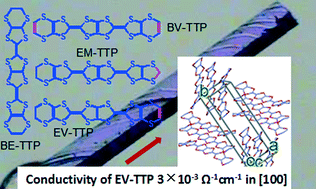Full-capped 12-S-atom TTP derivatives (BV-TTP, BE-TTP, EM-TTP and EV-TTP): syntheses, structures and charge transport properties†
Abstract
By π-extending and ring-capping the bis-fused TTF moiety (namely TTP), several electrically conductive crystals of 12-S-atom TTP derivatives have been synthesized: (1) bis(vinylenedithio)-TTP which can be isolated as triclinic P![[1 with combining macron]](https://www.rsc.org/images/entities/char_0031_0304.gif) (t-BV-TTP) and monoclinic P21 (m-BV-TTP) polymorphs separately, (2) bis(ethylenedithio)-TTP (BE-TTP), (3) ethylenedithio-methylenedithio-TTP (EM-TTP), (4) ethylenedithio-vinylenedithio-TTP (EV-TTP). The structures of t-BV-TTP and EM-TTP crystals can be classified as all-parallel β-type, in which all molecules in the same 2-D molecular slab or in different slabs are all parallel packed. In contrast, m-BV-TTP and BE-TTP crystals can be described as herring-bone β-type, in which the molecules in neighboring 2-D slabs are alternately in two directions. Among the above four β-type structures, the EM-TTP crystal shows the highest conductivity (σ = 7 × 10−3 Ω−1 cm−1 along [100] direction). The EV-TTP crystal belongs to a kind of three-by-three κ-type structure and its conductivity was measured to be 3 × 10−3 Ω−1 cm−1 along [100] direction. The calculated hole mobilities of the title TTP derivatives, by DFT method and the host-caged approach, are larger than that of the dithiophene-TTF (DT-TTF) crystal.
(t-BV-TTP) and monoclinic P21 (m-BV-TTP) polymorphs separately, (2) bis(ethylenedithio)-TTP (BE-TTP), (3) ethylenedithio-methylenedithio-TTP (EM-TTP), (4) ethylenedithio-vinylenedithio-TTP (EV-TTP). The structures of t-BV-TTP and EM-TTP crystals can be classified as all-parallel β-type, in which all molecules in the same 2-D molecular slab or in different slabs are all parallel packed. In contrast, m-BV-TTP and BE-TTP crystals can be described as herring-bone β-type, in which the molecules in neighboring 2-D slabs are alternately in two directions. Among the above four β-type structures, the EM-TTP crystal shows the highest conductivity (σ = 7 × 10−3 Ω−1 cm−1 along [100] direction). The EV-TTP crystal belongs to a kind of three-by-three κ-type structure and its conductivity was measured to be 3 × 10−3 Ω−1 cm−1 along [100] direction. The calculated hole mobilities of the title TTP derivatives, by DFT method and the host-caged approach, are larger than that of the dithiophene-TTF (DT-TTF) crystal.


 Please wait while we load your content...
Please wait while we load your content...